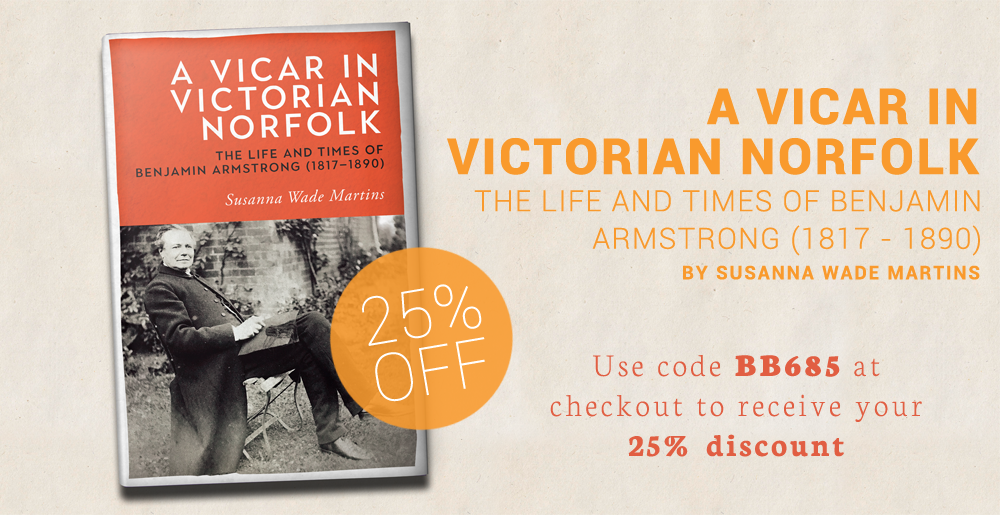Our beloved festive traditions were created in the Victorian age; the Christmas Tree, crackers, mulled wine, and parlour games. But what was Christmas like in a typical Victorian country vicarage? We are picturing a cosy Dickensian scene, set around a fireplace, overlooking the snow-speckled countryside, but it is unlikely the man of the house had time to put his feet up and read A Christmas Carol. Susanna Wade Martins, an Honorary Research Fellow at the University of East Anglia, who has written a biography of the famous Norfolk diarist, The Revd Benjamin Armstrong, gives the low-down on Christmas in Dereham.
The Revd Benjamin Armstrong was vicar of the small market town of East Dereham in Norfolk from 1850 to 1888. He kept detailed diaries during his time there, the eleven volumes of which have provide fascinating insights into rural life at the time.
Christmas in the nineteenth century was clearly a very busy time for a clergyman: the proceeds of various town charities had to be distributed. These included 400 loaves to the poor. Before Armstrong’s time the bread had been given after morning service on the Sunday previous to Christmas. Not surprisingly, this had resulted in an increased congregation that day. However, the Revd was a fine example of the then “new-style” Church of England clergy who lived in their parishes and showed a genuine concern for the well-being of their parishioners. He changed the system and took on the time-consuming task of driving around the parish delivering bread to those he felt needed it most. But the work didn’t stop there. The clothing charity also had to be cashed up, the stipends had to be paid to teachers, and Christmas dinners given. The church itself had to be ‘tastefully decorated with wreaths’. The old rustic orchestra had already been replaced by a choir and gradually more of the service was sung, although it was not until 1880 that carols were introduced in church. All choir members were given Christmas boxes.
As well as overseeing gifts for his flock, Armstrong was involved in family and personal preparations. Turkeys had to be sent to friends and relations in London. In 1859 he was proud of the fact that ‘the contents of the Christmas hampers, including the hampers themselves, were the production of our own premises’. Armstrong’s glebe included some marshes which could have produced willow with which to weave the hampers.
Christmas at the vicarage was very much a family occasion. It was to be a special time in 1855 as Armstrong’s parents were visiting from London. A Christmas tree decorated by his children ‘glittering with cheap presents for all’ is mentioned for the first time. On Christmas day Armstrong’s curate was invited, as well as 24 school children who sang for the family. All received small presents and there was a magic lantern show as well as parlour games.
In 1857 however, the normal festivities were limited as all the children were in bed with measles, ‘but their confinement was mitigated by a box of very expensive presents from Grandmama Duncombe’ (his wife’s mother).
Christmas was also the season of parties and every year there was a children’s party at the vicarage which was also attended by parents. Armstrong’s keen sense of social divisions is shown when describing arrangements for ‘this annual re-union (which) allows us to invite many whom we could not ask to dinner and is useful in a parochial as well as in a social way’ (1861).

(Image: The Book of Christmas, Project Gutenberg, Public Domain)
Armstrong’s diaries, which remained locked until they were broken open by his grandson in the 1940s, provide a remarkable insight not only into family and social life in a small market town in Victorian England: they also allow for an assessment of the influence of the changes sweeping through both the Anglican church at the time and market towns such as Dereham where railways, bringing with them industry, were adapting to a modernising world.
The Revd Benjamin Armstrong is the subject of a new biography, A Vicar in Victorian Norfolk, The Life and Times of Benjamin Armstrong (1817-1890), by Susanna Wade Martins, published by Boydell Press.
Dr Susanna Wade Martins is an Honorary Research Fellow in the School of History at the University of East Anglia. Her previous publications include The East Anglian Countryside: Changing Landscapes 1870-1950 with Tom Williamson (2008), Coke of Norfolk, 1754-1842 (2009) and The Conservation Movement in Norfolk – A History (2015).

The Life and Times of Benjamin Armstrong (1817-1890)
by Susanna Wade Martins
£18.75 after discount




 The Arms and Armour of Death
The Arms and Armour of Death